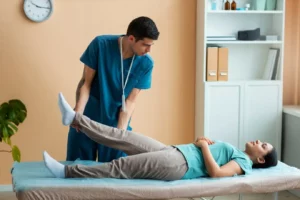Accidents can cause immediate and visible injuries, but some injuries remain hidden and don’t show symptoms until hours, days, or even weeks later. These hidden injuries can lead to serious complications if left untreated. At Injuries Wiki, we’re here to help you understand how to recognize and address these injuries to ensure a full recovery.
What Are Hidden Injuries?
Hidden injuries are those that don’t present obvious symptoms right away. Unlike cuts or broken bones, these injuries may take time to develop due to internal damage, inflammation, or delayed shock responses.
Why do hidden injuries occur?
- The body releases adrenaline and endorphins after an accident, temporarily masking pain.
- Some injuries cause internal damage that isn’t immediately visible.
- Soft tissue injuries may develop gradually as inflammation sets in.
Ignoring hidden injuries can lead to chronic pain, mobility issues, or long-term complications, making early detection and treatment crucial.
Common Hidden Injuries After an Accident
1. Whiplash
One of the most common injuries after car accidents, whiplash occurs when the head is forcefully jerked forward and backward.
Symptoms (May Take Days to Appear):
- Neck pain or stiffness
- Headaches
- Dizziness or blurred vision
- Shoulder or back pain
Treatment:
- Rest and apply ice or heat packs.
- Physical therapy to restore mobility.
- Chiropractic care to relieve tension in the neck and spine.
2. Concussions and Traumatic Brain Injuries (TBI)
Head trauma, even without a visible wound, can lead to brain injuries that develop over time.
Symptoms (May Take Hours or Days to Appear):
- Confusion or memory issues
- Nausea or vomiting
- Sensitivity to light or noise
- Difficulty concentrating
Treatment:
- Seek immediate medical evaluation if symptoms appear.
- Get plenty of rest and avoid screen time.
- Follow a doctor’s guidance on returning to normal activities.
3. Internal Bleeding
Internal injuries can be life-threatening if not detected early.
Symptoms (May Take Hours to Days to Appear):
- Abdominal pain or swelling
- Dizziness or fainting
- Deep bruising
- Rapid heartbeat or low blood pressure
Treatment:
- Emergency medical care is necessary.
- Surgery or blood transfusions may be required in severe cases.
4. Soft Tissue Injuries (Sprains, Strains, and Tears)
Soft tissue injuries affect muscles, tendons, and ligaments but may not show immediate signs.
Symptoms (May Take Days to Develop):
- Swelling and bruising
- Limited range of motion
- Persistent pain or stiffness
Treatment:
- Follow the R.I.C.E. Method (Rest, Ice, Compression, Elevation).
- Physical therapy or massage therapy for long-term healing.
- Pain management techniques such as heat therapy or chiropractic care.
5. Spinal Injuries and Herniated Discs
Back and spinal injuries can take time to cause noticeable pain, especially after a car accident or heavy impact.
Symptoms (May Take Days or Weeks to Appear):
- Numbness or tingling in the arms or legs
- Difficulty walking or standing for long periods
- Sharp back pain that worsens over time
Treatment:
- Seek imaging tests like X-rays or MRIs for proper diagnosis.
- Physical therapy and chiropractic adjustments.
- In severe cases, surgery may be required.
When to Seek Medical Attention for Hidden Injuries
It’s important to never ignore symptoms, even if they seem minor at first. Seek medical help if you experience:
✔ Persistent headaches or dizziness
✔ Unexplained bruising or swelling
✔ Neck, back, or joint pain that worsens over time
✔ Difficulty concentrating or memory problems
✔ Nausea, vomiting, or sudden fatigue
Legal Considerations for Hidden Injuries
Hidden injuries can complicate personal injury claims, especially if symptoms appear after an accident report is filed. At Injuries Wiki, we recommend:
- Seeking medical documentation as soon as symptoms appear.
- Keeping detailed records of symptoms, treatments, and doctor visits.
- Consulting a personal injury attorney if pursuing compensation for delayed-onset injuries.
How Injuries Wiki Can Help
At Injuries Wiki, we provide expert resources and guides to help accident victims recognize, treat, and seek legal support for hidden injuries. Whether you’re dealing with delayed symptoms or looking for recovery tips, we are here to support you every step of the way.
For more in-depth information on injury prevention, treatment, and legal options, visit our Topics Page or Contact Us for assistance.
Final Thoughts
Hidden injuries after an accident can be just as dangerous as visible wounds. By staying informed, recognizing delayed symptoms, and seeking timely medical care, you can prevent long-term health issues and protect your legal rights.
For more expert insights and safety tips, visit Injuries Wiki—your trusted source for injury prevention, recovery, and legal guidance.
Accidents can cause immediate and visible injuries, but some injuries remain hidden and don’t show symptoms until hours, days, or even weeks later. These hidden injuries can lead to serious complications if left untreated. At Injuries Wiki, we’re here to help you understand how to recognize and address these injuries to ensure a full recovery.
What Are Hidden Injuries?
Hidden injuries are those that don’t present obvious symptoms right away. Unlike cuts or broken bones, these injuries may take time to develop due to internal damage, inflammation, or delayed shock responses.
Why do hidden injuries occur?
- The body releases adrenaline and endorphins after an accident, temporarily masking pain.
- Some injuries cause internal damage that isn’t immediately visible.
- Soft tissue injuries may develop gradually as inflammation sets in.
Ignoring hidden injuries can lead to chronic pain, mobility issues, or long-term complications, making early detection and treatment crucial.
Common Hidden Injuries After an Accident
1. Whiplash
One of the most common injuries after car accidents, whiplash occurs when the head is forcefully jerked forward and backward.
Symptoms (May Take Days to Appear):
- Neck pain or stiffness
- Headaches
- Dizziness or blurred vision
- Shoulder or back pain
Treatment:
- Rest and apply ice or heat packs.
- Physical therapy to restore mobility.
- Chiropractic care to relieve tension in the neck and spine.
2. Concussions and Traumatic Brain Injuries (TBI)
Head trauma, even without a visible wound, can lead to brain injuries that develop over time.
Symptoms (May Take Hours or Days to Appear):
- Confusion or memory issues
- Nausea or vomiting
- Sensitivity to light or noise
- Difficulty concentrating
Treatment:
- Seek immediate medical evaluation if symptoms appear.
- Get plenty of rest and avoid screen time.
- Follow a doctor’s guidance on returning to normal activities.
3. Internal Bleeding
Internal injuries can be life-threatening if not detected early.
Symptoms (May Take Hours to Days to Appear):
- Abdominal pain or swelling
- Dizziness or fainting
- Deep bruising
- Rapid heartbeat or low blood pressure
Treatment:
- Emergency medical care is necessary.
- Surgery or blood transfusions may be required in severe cases.
4. Soft Tissue Injuries (Sprains, Strains, and Tears)
Soft tissue injuries affect muscles, tendons, and ligaments but may not show immediate signs.
Symptoms (May Take Days to Develop):
- Swelling and bruising
- Limited range of motion
- Persistent pain or stiffness
Treatment:
- Follow the R.I.C.E. Method (Rest, Ice, Compression, Elevation).
- Physical therapy or massage therapy for long-term healing.
- Pain management techniques such as heat therapy or chiropractic care.
5. Spinal Injuries and Herniated Discs
Back and spinal injuries can take time to cause noticeable pain, especially after a car accident or heavy impact.
Symptoms (May Take Days or Weeks to Appear):
- Numbness or tingling in the arms or legs
- Difficulty walking or standing for long periods
- Sharp back pain that worsens over time
Treatment:
- Seek imaging tests like X-rays or MRIs for proper diagnosis.
- Physical therapy and chiropractic adjustments.
- In severe cases, surgery may be required.
When to Seek Medical Attention for Hidden Injuries
It’s important to never ignore symptoms, even if they seem minor at first. Seek medical help if you experience:
✔ Persistent headaches or dizziness
✔ Unexplained bruising or swelling
✔ Neck, back, or joint pain that worsens over time
✔ Difficulty concentrating or memory problems
✔ Nausea, vomiting, or sudden fatigue
Legal Considerations for Hidden Injuries
Hidden injuries can complicate personal injury claims, especially if symptoms appear after an accident report is filed. At Injuries Wiki, we recommend:
- Seeking medical documentation as soon as symptoms appear.
- Keeping detailed records of symptoms, treatments, and doctor visits.
- Consulting a personal injury attorney if pursuing compensation for delayed-onset injuries.
How Injuries Wiki Can Help
At Injuries Wiki, we provide expert resources and guides to help accident victims recognize, treat, and seek legal support for hidden injuries. Whether you’re dealing with delayed symptoms or looking for recovery tips, we are here to support you every step of the way.
For more in-depth information on injury prevention, treatment, and legal options, visit our Topics Page or Contact Us for assistance.
Final Thoughts
Hidden injuries after an accident can be just as dangerous as visible wounds. By staying informed, recognizing delayed symptoms, and seeking timely medical care, you can prevent long-term health issues and protect your legal rights.
For more expert insights and safety tips, visit Injuries Wiki—your trusted source for injury prevention, recovery, and legal guidance.









